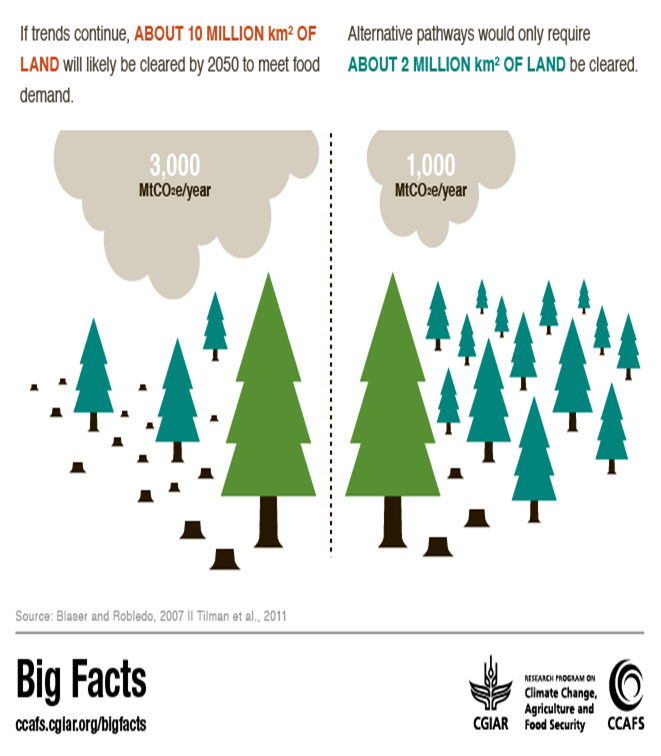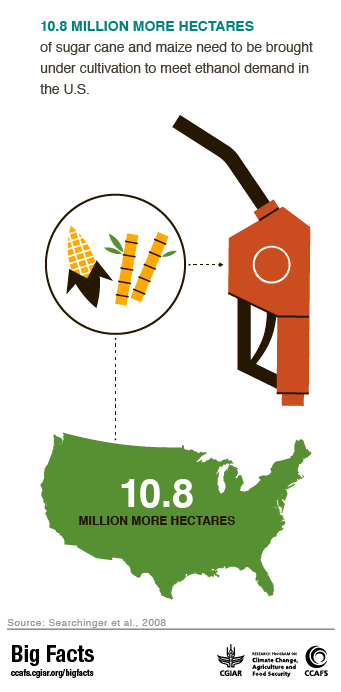Big facts: Focus on Food Emissions

This story spotlights some of the Big Facts on food emissions, and is part of a special blog series to complement the new Big Facts infographics website.
Food systems are complex systems that include the production, distribution, consumption, and disposal of food – including unnecessary waste. Each level and the system as a whole has a significant impact on the way we do agriculture, our current and future levels of food security, and of course, climate change. One of the most significant impacts is the sheer amount of global greenhouse gas (GHG) emissions which the food system produces.
Vermeulen et al. (2012) estimated that a staggering 19-29% of total global GHG emissions can be attributed to the food system – when taking into account the entire range of factors, from the production of food to the clearing of forests for pastures to the disposal of food waste. On its own, agriculture, that is, the production of food, was found to be responsible for the lion’s share of the emissions, 7,300-12,700MtCO2e every year, or 80-86% of total food systems emissions. The reason this figure is calculated in carbon dioxide equivalents is because although agriculture is not a large net CO2 emitter - agriculture is the main emitter of non-CO2 greenhouse gas emissions like methane and nitrous oxide, due in large part to livestock, rice farming, and soils. Globally, more than half (54%) of the emissions of these two potent GHGs are due to agriculture. As always, if we want to get the true picture, we need to look at the big picture.
Food and forests - a complicated relationship
When calculating a global figure for food system emissions, numerous variables must be taken into consideration – for instance, an important discussion is how large a part of the emissions coming from the clearing of forests (primarily rain forests in Latin America, Africa and South East Asia) should be allocated to agricultural activities. Such estimations are so uncertain that the Intergovernmental Panel on Climate Change (IPCC) specifically did not even try to come up with a number in its 2007 report. A study by Blaser and Robledo (2007) fixed this number at 75%, although it must be noted that thisis fraught with uncertainty.
Based on this number, Blaser and Robledo further estimated that deforestation and land use activities accounts for some 30-50% of all agricultural emissions and 4-14% of total global emissions. Although, as always, uncertainty remains a problem,uncertainty about both the size of total global emissions and emissions from deforestation contribute to the relatively large uncertainty ranges.
Looking to the future, if past trends for land use change can be used as an indicator for future changes to land use, Tilman et al. (2011) found that some 10 million km2 of land will be cleared by 2050 to meet increased food demand, leading to annual emissions of 3,000 MtCO2e. However, they also found that it was possible to significantly reduce land clearing and emissions (to ~2 million km2 and GHG emissions to 1,000 MtCO2e per year) by adopting a future course that spares more land by using land more intensively, with careful management of water, fertilizers, energy and labour.
Decision-making under uncertainty
When researching and developing a project like Big Facts, a number of decisions have to be made; some researchers find evidence for one trend, while others find something different. Obviously, estimates about emissions and land clearing depend on the assumptions that one make about future food demand – there is agreement that food production need to grow to keep up with population growth and changing dietary patterns, but how much exactly remains unclear.
Adding to the uncertainty is the evolving biofuels market; although a promising technology, at the moment, manufactured liquid biofuels do not necessarily produce fewer greenhouse gas emissions across the full product lifecycle (from fields to wheels) when compared to fossil fuels. If current production patterns are followed, increasing the use of biofuels can lead to increased emissions from agriculture as new land will have to be cleared to maintain the current production of food.
Changing cultures to change climates
Overall, the food system makes a large contribution to global GHG emissions, and with increasing demand for food and biofuels, this number might well rise in the coming decades. To lower the increase of emissions (or perhaps even reduce emissions?) it will be necessary to reduce waste (around a third of all food produced ends up as waste), change consumption patterns to diets with less meat and dairy products, reduce agriculture-induced deforestation, and change agricultural practices. These and several other challenges loom, so there is plenty of work to be done for researchers, farmers, politicians, activists, consumers, and everyone else interest in food in the coming decades.
HAVE YOUR SAY
Hopefully, the Big Facts project will help people understand and act upon some of these challenges. With these challenges and opportunities in mind, we invite you to get all the facts on Food Emissions from the Big Facts website. Explore away! And should you have any questions or comments, these are most welcome. Simply comment below or send us an email.
Now you can get all the Big Facts on the links between climate change, agriculture and food security at ccafs.cgiar.org/bigfacts2014. The new site features over 100 stunning infographics that illustrate the most up-to-date, thoroughly researched information on these topics.
Big Facts is also an open-access resource. You can download and share the graphics with your friends and colleagues and use them in your presentations and reports. Please do not hesitate to send us any suggestions for improvements, either by commenting below or sending us an email.
This story is part of a series focusing on the Big Facts on various topics and in different regions; join the conversation at ccafs.cgiar.org/blog and on twitter using #bigfacts



